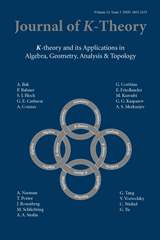No CrossRef data available.
Article contents
Inductive Limits of K-theoretic Complexes with Torsion Coefficients
Published online by Cambridge University Press: 21 December 2007
Abstract
We present the first range result for the total K-theory of C*-algebras. This invariant has been used successfully to classify certain separable, nuclear C*-algebras of real rank zero. Our results complete the classification of the so-called AD algebras of real rank zero.
- Type
- Research Article
- Information
- Copyright
- Copyright © ISOPP 2008
References
1.Bödigheimer, C.F.. Splitting the Künneth sequence in K-theory. Math. Ann., 242:159–171, 1979.CrossRefGoogle Scholar
2.Bödigheimer, C.F.. Splitting the Künneth sequence in K-theory, II. Math. Ann., 251:249–252, 1980.Google Scholar
4.Dădărlat, M. and Eilers, S.. Compressing coefficients while preserving ideals in the K-theory for C*-algebras. K-Theory, 14:281–304, 1998.CrossRefGoogle Scholar
5.Dădărlat, M. and Eilers, S.. The Bockstein map is necessary. Canad. Math. Bull., 42(3):274–284, 1999.CrossRefGoogle Scholar
6.Dădărlat, M. and Gong, G.. A classification result for approximately homogeneous C*-algebras of real rank zero. Geom. Funct. Anal., 7(4):646–711, 1997.CrossRefGoogle Scholar
7.Dădărlat, M. and Loring, T.A.. Classifying C*-algebras via ordered, mod-p K-theory. Math. Ann., 305(4):601–616, 1996.CrossRefGoogle Scholar
8.Dădărlat, M. and Loring, T.A.. A universal multicoefficient theorem for the Kasparov groups. Duke Math. J., 84(2):355–377, 1996.CrossRefGoogle Scholar
9.Effros, E.G., Handelman, D.E., and Shen, C.L.. Dimension groups and their affine representations. Amer. J. Math., 102(2):385–407, 1980.Google Scholar
10.Eilers, S.. Invariants for AD Algebras. PhD thesis, Copenhagen University, November 1995.Google Scholar
11.Eilers, S.. A complete invariant for AD algebras with real rank zero and bounded torsion in K 1. J. Funct. Anal., 139:325–348, 1996.CrossRefGoogle Scholar
12.Eilers, S.. Künneth splittings and classification of C*-algebras with finitely many ideals. In Operator algebras and their applications (Waterloo, ON, 1994/1995), volume 13 of Fields Inst. Commun., pages 81–90. Amer. Math. Soc., Providence, RI, 1997.CrossRefGoogle Scholar
13.Eilers, S.. Approximate homogeneity of C*-algebras with finitely many ideals. Math. Proc. R. Ir. Acad., 101A(2):149–162, 2001.Google Scholar
14.Eilers, S. and Elliott, G.A.. The Riesz property for the K*-group of a C*-algebra of minimal stable and real rank. C. R. Math. Acad. Sci. Soc. R. Can., 25(4):108–113, 2003.Google Scholar
15.Elliott, G.A.. Dimension groups with torsion. Internat. J. Math., 1(4):361–380, 1990.CrossRefGoogle Scholar
16.Elliott, G.A.. On the classification of C*-algebras of real rank zero. J. Reine Angew. Math., 443:179–219, 1993.Google Scholar
18.Fuchs, L.. Infinite Abelian Groups I. Academic Press, New York, San Francisco, London, 1970.Google Scholar
19.Goodearl, K. R.. K 0 of multiplier algebras of C*-algebras with real rank zero. K-Theory, 10(5):419–489, 1996.Google Scholar
20.Goodearl, K.R.. Partially Ordered Abelian Groups with Interpolation. American Mathematical Society, Providence, R.I., 1986.Google Scholar
21.Lin, H. and Rørdam, M.. Extensions of inductive limits of circle algebras. J. London Math. Soc., 51(2):603–613, 1995.CrossRefGoogle Scholar
22.Riesz, F.. Sur quelques notions fondamentales dans la théorie générale des opérations linéaires. Ann. of Math., 41:174–206, 1940.Google Scholar
23.Schochet, C.. Topological methods for C*-algebras IV: Mod p homology. Pacific J. Math., 114:447–468, 1984.CrossRefGoogle Scholar
24.Villadsen, J.. The range of the Elliott invariant of the simple AH-algebras with slow dimension growth. K-theory, 15(1):1–12, 1998.Google Scholar
25.Wehrung, F.. Injective positively ordered monoids. I. J. Pure Appl. Algebra, 83(1):43–82, 1992.CrossRefGoogle Scholar
26.Zhang, S.. A Riesz decomposition property and ideal structure of multiplier algebras. J. Operator Theory, 24:209–225, 1990.Google Scholar


